Want to create a music streaming app?
Whether you’re a budding entrepreneur or an established business, the project of developing a new digital product can be full of challenges and unknown paths.
That’s why we have brought to you this music streaming app development guide, where we shall be going through everything you need to know.
Covering everything from a basic overview to a detailed step-by-step process of how to build a music app and much more. Therefore, with this being said, let’s get started:
Music Streaming App, an Overview
What are music streaming apps?
Music streaming apps are a form of on-demand apps that allow users to explore, stream, and save music across different genres, artists, and types.
This is an app that doesn’t need any introduction since we all have been using music streaming apps for years now. Spotify, Shazam, and Pandora are just a few examples of popular music streaming apps.
With this out of the way, let’s dive deeper into the market via statistics:
- The global music streaming market size was estimated at USD 34.53 billion in 2022 and is expected to reach USD 103.07 billion by 2030, with a CAGR of 14.4% from 2023 to 2030.
- Increasing smartphone penetration, rising internet accessibility, and growing consumer preference for on-demand content are driving market growth.
- Music streaming makes up 84% of music industry revenue.
- Almost half of all music streaming app revenue comes from the US.
- Over 600 million people subscribe to music streaming platforms globally.
- 78% of people listen to music via a streaming service, with YouTube having the most active users (2.5 billion) followed by Tencent platforms (800 million+) and Spotify (381 million).
- Music streaming apps generated $43.3 billion in revenue in 2022, a 15% increase compared to the previous year.
That’s exact reason why this form of on-demand app development is so popular among the investors and businesses alike.
Now, before we learn more about how to create a music streaming app, let’s first discuss how it works.
How Does A Music Streaming App Work?
To make a music streaming app, you first need to understand how these things work.
So, let’s do just that.
A music streaming app works through a complex interplay of technologies that deliver music content to your device while you listen.
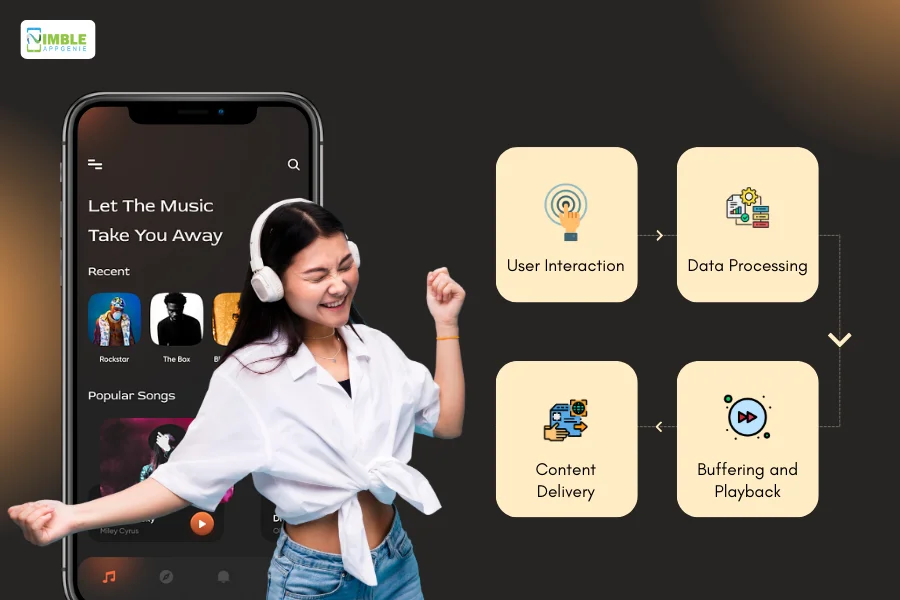
Here’s a breakdown of the key steps:
1. User Interaction
You can browse the app’s library, search for specific music, or select from personalized recommendations.
2. Data Processing
Your request is sent to the app’s servers, which identify the chosen song and its location within the music storage system.
3. Content Delivery
The music file isn’t downloaded entirely. Instead, it’s broken down into small packets and streamed sequentially.
This streaming happens using protocols like HTTP Live Streaming (HLS) or MPEG-DASH, ensuring smooth playback even with fluctuating internet speeds.
4. Buffering and Playback
The app pre-buffers a short segment of the song (usually a few seconds) before you hear it. This ensures continuous playback without interruptions.
As you listen, the app continues to download and buffer the following segments, maintaining a seamless listening experience.
5. Additional Features:
Some apps offer offline listening by allowing you to download specific songs or playlists for later use without an internet connection.
Advanced features like high-fidelity audio require different data transfer protocols and higher bandwidth for richer sound quality.
Behind the Scenes
- Music streaming apps rely on vast data centers housing music libraries and powerful servers to handle millions of simultaneous user requests.
- Complex licensing agreements ensure artists and rights holders are compensated for each stream.
- Advanced algorithms curate personalized recommendations, analyze listening habits, and power search functionalities.
Now that we are done with the working of music streaming app, it’s time to look at the most popular ones in the market.
Popular Music Streaming Apps to Learn From
Now, let’s look at some of the most popular music streaming apps and get inspired to build an online music streaming app of your own.
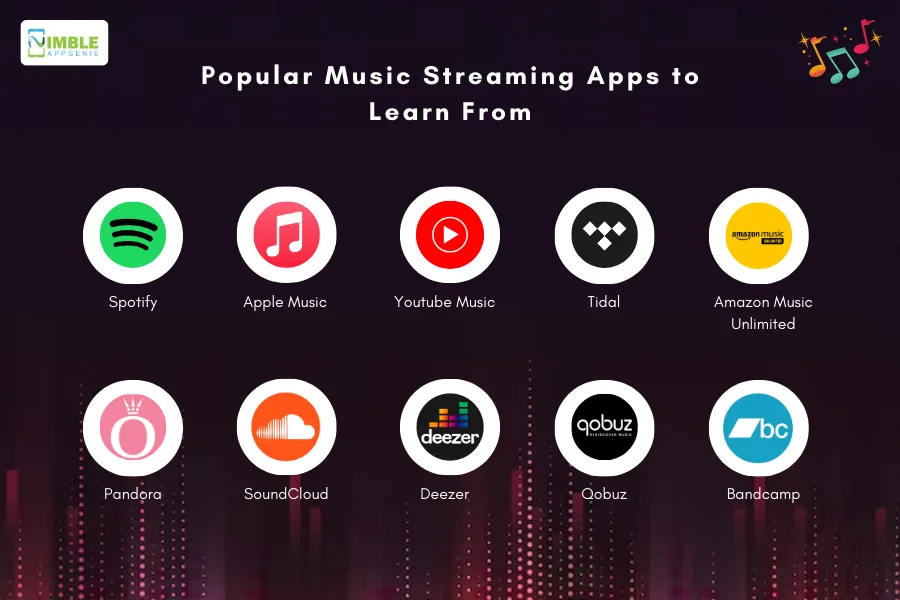
Let’s get started:
1. Spotify
A leading music streaming service offering a vast library of songs, playlists, and podcasts, with personalized recommendations and user-generated content.
- Market leader: With over 422 million monthly active users, Spotify is the world’s most popular music streaming service.
- Key features: Extensive music library, personalized recommendations, social features, podcasts, offline listening, high-quality audio options.
- What to learn: User-friendly interface, data-driven recommendations, successful freemium model, and integration with social media.
2. Apple Music
Apple’s music streaming platform providing access to millions of songs, curated playlists, exclusive releases, and integration with the Apple ecosystem.
- Deep integration with Apple ecosystem: Tightly integrated with Apple devices and services, offering a seamless experience for Apple users.
- Key features: Large music library, curated playlists, exclusive content, high-quality audio options, music videos, integration with Siri.
- What to learn: Platform-specific strengths, curated content strategy, exclusive content acquisition, integration with voice assistants.
3. YouTube Music
A music streaming service from YouTube offering a wide range of songs, music videos, live performances, and remixes alongside personalized recommendations and playlists.
- Vast video library: Combines music streaming with access to YouTube’s extensive music video library.
- Key features: Music and music videos, personalized recommendations, live performances, integration with YouTube Premium.
- What to learn: Leveraging existing platform strengths, combining audio and video content, integration with other services.
4. Tidal
Known for its high-fidelity audio quality, Tidal offers a diverse catalog of music, exclusive content, and curated playlists, with a focus on supporting artists and creators.
- Focus on high-fidelity audio: Offers lossless and master-quality audio options for audiophiles.
- Key features: High-fidelity audio, exclusive content, artist-centric approach, music videos, curated playlists.
- What to learn: Catering to specific user segments, high-quality audio offerings, artist partnerships, exclusive content strategy.
5. Amazon Music Unlimited
Amazon’s music streaming service provides access to millions of songs, playlists, and stations, with integration across Amazon devices and Prime membership benefits.
- Integration with Amazon Prime: Bundled with Amazon Prime subscriptions, offering additional value for existing Prime users.
- Key features: Large music library, integration with Alexa, offline listening, curated playlists, podcasts.
- What to learn: Bundle with existing services, voice assistant integration, leveraging existing user base.
6. Pandora
The radio-style music streaming service offers personalized stations based on user preferences, alongside curated playlists and podcasts.
- Personalized radio stations: Creates personalized radio stations based on user preferences and feedback.
- Key features: Personalized radio stations, ad-supported and subscription tiers, artist discovery, offline listening.
- What to learn: Personalized content discovery, ad-supported monetization models, and user feedback integration.
7. SoundCloud
A platform for artists to share and discover music, featuring a vast library of user-generated tracks, remixes, podcasts, and DJ sets.
- Focus on independent artists: A popular platform for independent artists to upload and share their music.
- Key features: Large library of independent music, direct support for artists, social features, remixes and collaborations.
- What to learn: Supporting independent artists, fostering a creative community, and social interaction features.
8. Deezer
The music streaming service offers a diverse catalog of songs, playlists, and podcasts with personalized recommendations and offline listening capabilities.
- Global reach: Available in over 180 countries, offering a diverse music selection.
- Key features: Large music library, curated playlists, high-quality audio options, live radio, lyrics, podcasts.
- What to learn: Global reach and localization, diverse content offerings, integrating different audio formats.
9. Qobuz
Known for its high-resolution audio quality, Qobuz provides access to a vast library of lossless and hi-res music, along with editorial content and curated playlists.
- Focus on classical and high-fidelity music: Offers a curated selection of classical and high-fidelity music.
- Key features: High-fidelity, lossless audio, editorial curation, exclusive content, in-depth artist information.
- What to learn: Catering to niche audiences, editorial content curation, high-quality audio focus.
10. Bandcamp
A platform for independent artists and labels to sell and stream music, offering a diverse range of genres, direct support for artists, and options for purchasing music in various formats.
- Direct support for artists: Allows artists to sell their music directly to fans, keeping a larger share of the revenue.
- Key features: Direct-to-fan models, artist profiles, exclusive releases, fan community features.
- What to learn: Supporting artists directly, fan engagement, community building, and alternative monetization models.
By carefully analyzing these different music streaming apps and their strengths and weaknesses, you can gain valuable insights that can help you develop your own successful music streaming service.
Should You Develop a Music Streaming App?
Before we move any further in this guide to create a music streaming app, let’s answer a very important question.
“Should you develop a music streaming app?”
Developing any mobile application is a considerable investment. So it goes without saying that anyone would look for reasons to invest in app development before going for it.
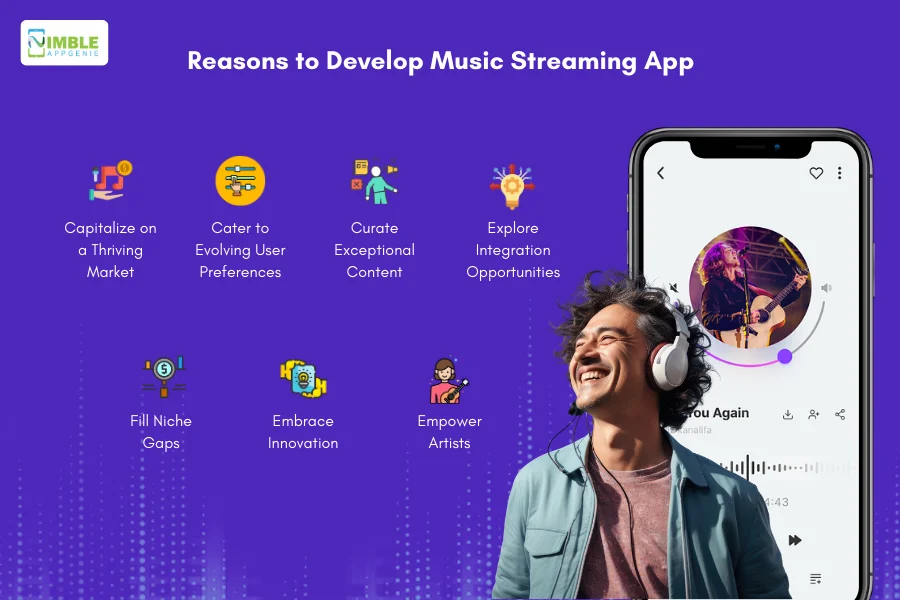
So, let’s look at some of these top reasons to build a music streaming app:
1] Capitalize on a Thriving Market
Do you want to make millions in revenue (or even more)?
As the statistics show, the music streaming industry is booming, projected to reach $103 billion by 2030. This presents a significant opportunity for new entrants to capture a share of the growing market.
There are already established players exploiting the market’s potential, something that you can do by creating a music app.
2] Cater to Evolving User Preferences
As the time changes, everything changes with it. Especially people’s wants and needs
In the same fashion, younger generations heavily utilize streaming services, and their demand for personalized experiences and diverse content opens doors for innovative apps.
This is one of the big reasons to create a music streaming app that caters to the people of today.
3] Curate Exceptional Content
With a great music streaming app, it’s easy to offer expertly curated playlists based on moods, activities, or themes, providing users with unique and personalized listening experiences.
Needless to say, this helps capture the user base and create a name for your business in the market.
4] Fill Niche Gaps
You can create music streaming and reach the unreachable.
The market is filled with potentially untouched segments. Time and time again, we see new solutions tapping into this market to generate seamless revenue.
Identify underserved audiences, like classical music enthusiasts or fans of specific genres, and tailor your app to their unique needs and preferences.
5] Embrace Innovation
The world yearns for innovation.
And everyone has their own contribution to it. Your idea for a music app can be the next big that disrupt the market and changes the way people listen to it forever.
Differentiate yourself with cutting-edge features like AI-powered recommendations, immersive AR/VR experiences, or social listening functionalities.
6] Empower Artists
By creating a music streaming app like Spotify or Pandora, you can bridge the gap between fans and artists.
Implement a direct-to-fan model, allowing artists to sell music and connect directly with fans, fostering a creator-centric approach.
7] Explore Integration Opportunities
Lastly, when you build a music streaming app, it enables the business to partner with other platforms like fitness apps, social media, or gaming services to expand your reach and offer a more integrated user experience.
So, these are some of the reasons to make a music streaming application. It’s time to learn how to do so.
Steps To Create a Music Streaming App
It’s finally time to answer the question, “how to build a music streaming app?”
In this step-by-step guide to create a music streaming app, we shall be going through the entire app development process, discussing everything in detail.
Therefore, with this being said, let’s get right into it, starting with the first phase:
Step 1: Conceptualization
The first step is to come up with an idea.
Here, you need to define your niche and target audience.
What makes your app unique? Are you focusing on a specific genre, personalized recommendations, or social features?
This might seem like the simplest step, but it is the hardest one. In any case, once this is done, we will move to market research.
Step 2: Market Research
Now that you have a basic idea of the music streaming mobile app you want to create, it’s time to go for app’s market research.
Analyze existing competitors, identify their strengths and weaknesses, and understand user preferences.
The data collected via all of that will work as fuel for the rest of the development process. That’s what makes it.
Step 3: Monetization Strategy
So, you have an idea to create a music streaming app and now the data to back it up.
It’s time to make money with a music app. So, how do you do it?
Well, there are various ways and strategies to do so. And that’s what we call app monetization channels.
Let’s look at a few of them below.
| Monetization Strategy | Description | Advantages | Disadvantages |
| Subscriptions | Monthly or annual fee for unlimited access to the music library. | Predictable revenue streams and high user engagement. | Requires user commitment and competitive pricing. |
| Advertising | Displaying targeted ads within the app. | Free for users and additional revenue streams. | Can be intrusive, disrupt user experience. |
| Freemium Model | Basic and premium features require a subscription. | Entices users with free tier, upsells to premium. | Requires balancing of free and premium features. |
| In-App Purchases | Selling additional features like ad-free listening, high-quality audio and exclusive content. | One-time revenue caters to specific user needs. | Can fragment user base, requires careful selection of in-app purchases. |
| Sponsorships | Partnering with brands for product placement and exclusive content. | Generates revenue without impacting user experience. | Requires brand alignment, limited reach compared to other strategies. |
| Merchandise | Selling branded merchandise like t-shirts, mugs, or headphones. | Diversifies revenue stream, promotes brand loyalty. | Requires investment in inventory and logistics, may not appeal to all users. |
With this said, you need to choose your revenue model (subscriptions, ads, in-app purchases).
However, let it be known that not all models are made equal for music streaming applications. Paid subscriptions account for 23% of all music streaming revenue, while ad-supported tiers, in-app purchases, and sponsored content contribute to the remainder. This is why its people go for subscription apps.
Speaking of which, let’s move to the next step of learning how to develop a music app.
Step 4: Feature Planning
It’s time to choose a feature to include when you start a music streaming app.
Here, we need to prioritize essential features like music library, playback controls, playlists, search, and user profiles.
Plus, it’s also important to consider advanced features like offline listening, lyrics, podcasts, and social integration.
(We shall be discussing features in detail later down the line)
With this, we are done with the first phase of building music application, let’s move to the second.
Step 5: Music Licensing
Since we are talking about making a music streaming app, it’s important to focus on the legal and government aspects, with licensing being the most important.
You see, more often than not new songs and other form of music is patented by the artist. For that reason, it’s important to secure music licensing agreements with rights holders to legally stream their content.
In any case, once you are done with the legal and licensing work, it’s time to go choose
Step 6: Selecting Technologies
It’s time to select technologies that will be used to create a music app.
This includes a choice between whether you hire iOS app developer or android app developer.
In addition to this, we shall also be making a lot of other choices, which would be easier defined as mobile app’s tech stack.
| Components | Technology Options | Pros |
| 1. Frontend | React Native, Flutter, Native (iOS/Android) | Cross-platform (React Native/Flutter), Native performance (iOS/Android), Customization |
| 2. Backend | Node.js (Express), Python (Django/Flask), Java (Spring) | Scalability, Mature Ecosystem, Open-source |
| 3. Database | MySQL, PostgreSQL, Cassandra | Relational (MySQL/PostgreSQL), Scalable (Cassandra), Open-source |
| 4. Caching | Redis, Memcached | Improves performance, Reduces server load |
| 5. Authentication/Authorization | Firebase Authentication, AWS Cognito, Auth0 | Easy integration, Secure, Scalable |
| 6. Streaming Protocol | HTTP Live Streaming (HLS) MPEG-DASH | Widely supported, Adaptive bitrate streaming |
| 7. Cloud Infrastructure | AWS, Azure, Google Cloud Platform | Scalability, High availability, Managed services |
| 8. Music Storage | Amazon S3, Google Cloud Storage, Azure Blob Storage | Scalable, Cost-effective |
| 9. Data Analytics | Google Analytics, Mixpanel, Amplitude | User behavior insights, A/B testing |
| 10. Push Notifications | Firebase Cloud Messaging, Amazon SNS, OneSignal | Real-time updates and User engagement |
| 11. Payment Processing | Stripe, PayPal, Apple Pay, Google Pay | Secure, Widely adopted |
Once we are done with this, it’s time to move to the next section of the blog, where we shall discuss the back-end development.
Step 7: UI/UX Design
It’s time to start designing the app.
Here, we create an intuitive and user-friendly interface that aligns with your brand and target audience. UI/UX Design plays an important role on many levels.
To get a better result, it’s highly recommended that you take inspiration from Android and iOS app design guidelines.
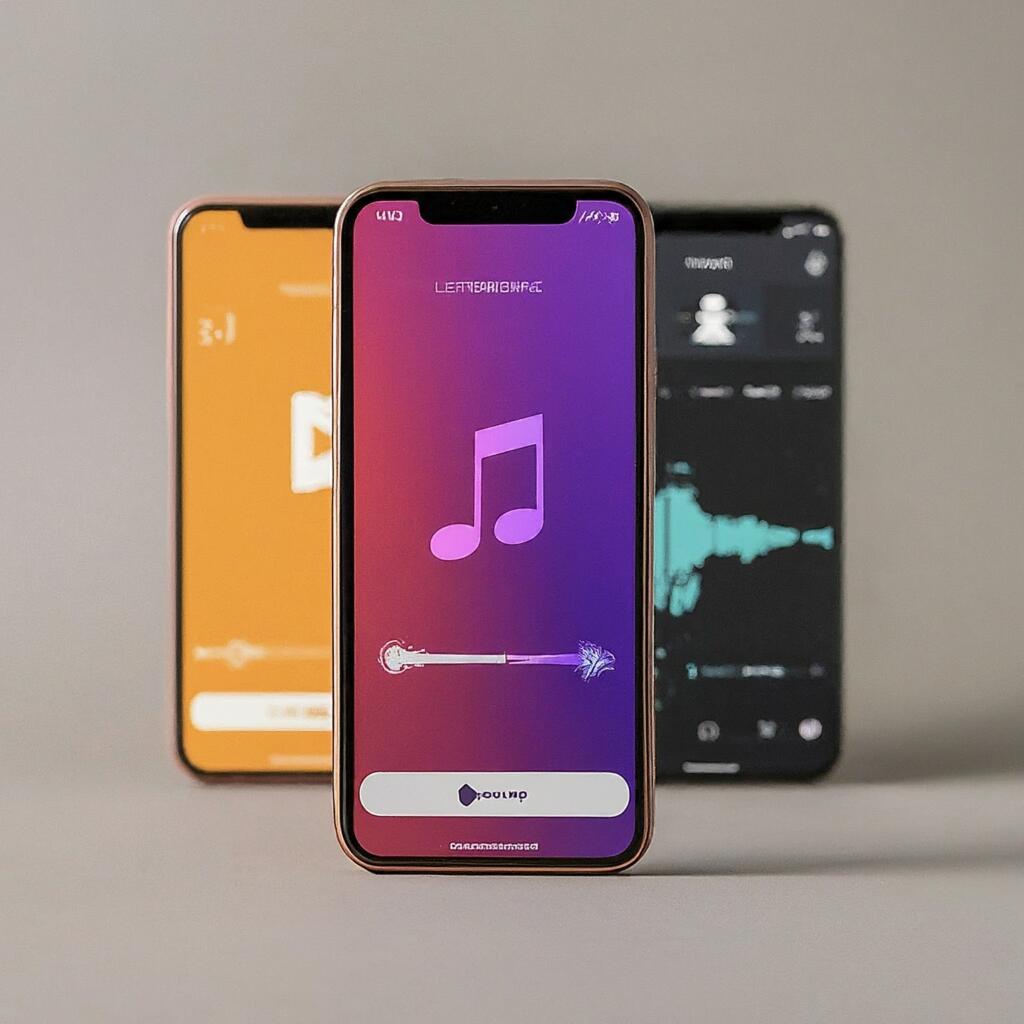
In any case, once you are done with the music streaming app design, we will move to app development section.
Step 8: App Development
It’s finally time to develop the app.
In this step those different components are combined to form the music streaming application.
Here the developers work tirelessly to make different components work together, generating the source code in the form of a mobile application.
By far, this is the most time consuming and resource intensive.
In any case, once this is done, we have an almost-ready music streaming app. But the work doesn’t end here.
Step 9: Testing and Quality Assurance
Now that we are done with “how to make a music app” it’s time to learn how to polish this product.
This is done via mobile app testing.
In this step, the team of QA and testers will rigorously test the app on various devices and platforms to identify and fix bugs.
All of the issues are solved and necessary changes have been made as per the client’s preference. With all said and done, the app is sent for deployment in the final phase of online music streaming app development guide.
Step 10: Deployment
It’s finally time to launch the app.
Now, this is a non-technical step, yet not all that simple. It highly depends on the platform you have developed app on.
Meaning, the iOS app deployment process and Android app deployment process are completely different.
In any case, once you have submitted the music streaming app for review, it usually takes 2 weeks for the app to go live.
Once this is done, you can start app store optimization which is a part of mobile app marketing all together.
Step 11: Maintenance
Done with everything? Well, that’s how to make a music streaming app. But the work doesn’t end here.
If you want the app to reach the top spot and be relevant to the user, you need to invest in mobile app maintenance services.
Nimble AppGenie, Your Music Streaming App Development Partner
Are you planning to develop a music streaming app? Developing a mobile app can be a complex process, needless to say.
So, why not leave it to the experts?
Nimble AppGenie is a market leading Music Streaming App Development Company and is here to help you.
With 700+ projects under our name and recognition from top platforms like Clutch.co, TopDevelopers, GoodFirms, and DesignRush, we are one of the best out there.
Nujaxx – Innovative Music Streaming App Developed by Us
Nujaxx is a well-known UK-based music streaming app that was brought to life by an expert team of app developers and designers at Nimble AppGenie.
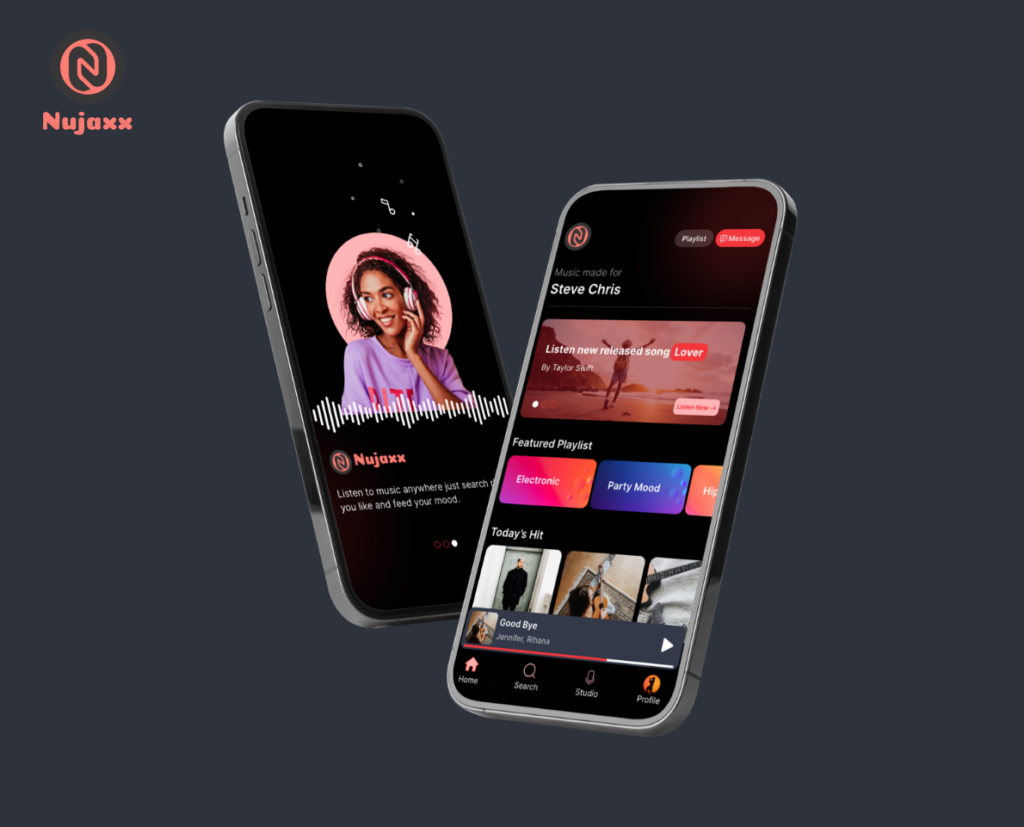
Combining our technical expertise and our client’s amazing idea, app came to life with amazing features like:
- Discover How To Find New Music
- In-App Music Player
- My Studio For Users
- Unique Voucher System
- Dedicated Artist Panel
- Easy to Use Admin Panel
- And much more
The platform is available on both iOS and Android apps, built to handle traffic of millions while helping our clients generate even more in revenue.
Do you want to develop an app like Nujaxx? Hire Mobile App Developers with Nimble AppGenie and give a boost to your journey to the top of the market.
We’re here to help you, contact us today.
Essential Music Streaming App Features
If we are going for an innovative mobile app development project like building app for music streaming, it’s important to focus on features.
To help you with just that, let’s look at the essential features for the three core panel of music streaming app.
After this, we shall go through the advanced features.
| Features | User Panel | Artist Panel | Admin Panel |
| 1. Account Management | Profile editing, login/logout, password reset, subscription management | Profile editing, contact information, payout method | User management (CRUD), access control, security settings |
| 2. Music Discovery & Playback | Search, browse the music library, play/pause, skip, volume control, create/edit playlists, offline listening | Upload music, edit metadata (titles, genres, etc.), track performance (streams, likes, etc.) | Content management (add/edit/remove music), manage licensing, monitor platform usage |
| 3. Personalization | Saved playlists, listening history, recommendations based on preferences, user profile | Manage fan engagement tools (social media links, bios, merch links) | Analyze user behavior, generate reports, and manage recommendation algorithms |
| 4. Notifications & Communication | New releases, playlist updates, artist updates, promotional messages | Receive fan messages, track notifications, promotional tools | User communication tools (email blasts, push notifications), system alerts, artist communication tools |
| 5. Settings | Audio quality, data usage, notifications, privacy settings | Music distribution settings and payout preferences | System settings (security, backup, user permissions), manage app features, manage integrations |
| 6. Help & Support | Access FAQs and contact support team | Access dedicated artist support | Manage user support tickets, knowledge base, and communication channels |
Advanced Music Streaming App Feature
One of the important part of learning how to develop a music streaming app that disrupts the market is learning to select the right features.
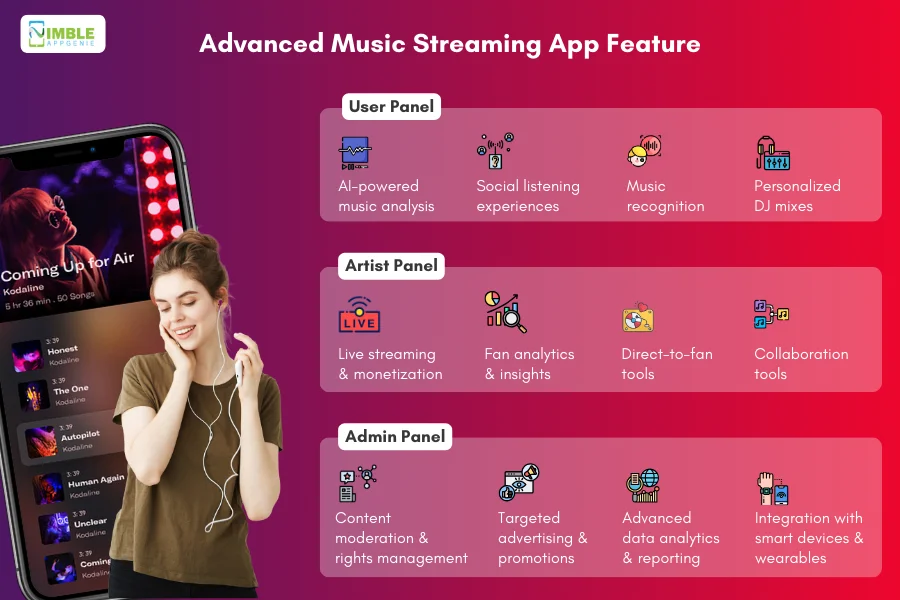
Speaking of which, now that we are done with the:
1. User Panel
- AI-powered music analysis: Create playlists based on mood, activity, or even weather using AI analysis of music characteristics.
- Social listening experiences: Collaborate with friends on playlists, share listening activities, and discuss music through chat or forums.
- Music recognition: Identify songs playing in the surrounding environment using the device’s microphone.
- Personalized DJ mixes: Utilize AI to create dynamic DJ mixes based on user preferences and real-time data.
- High-fidelity & Spatial audio: Cater to audiophiles with premium high-fidelity and immersive spatial audio options.
2. Artist Panel
- Live streaming & monetization: Host live concerts, events, and interactive sessions directly within the app with built-in monetization options.
- Fan analytics & insights: Gain detailed insights into fan demographics, listening habits, and engagement metrics.
- Direct-to-fan tools: Sell merchandise, tickets, and other exclusive content directly to fans through the app.
- Collaboration tools: Connect with other artists for collaborative projects, remixes, and guest appearances.
- AI-powered content creation: Utilize tools like AI chatbots to assist with songwriting, music production, and personalized fan interactions.
3. Admin Panel
- Content moderation & rights management: Implement robust systems for content moderation, copyright protection, and artist royalty management.
- Targeted advertising & promotions: Offer targeted advertising options to brands and artists within the app based on user data and demographics.
- Advanced data analytics & reporting: Gain comprehensive insights into user behavior, platform performance, and market trends with detailed reporting tools.
- Integration with smart devices & wearables: Enable seamless music control and personalized experiences across various smart devices and wearables.
- Augmented reality & virtual reality integration: Offer immersive music experiences through AR/VR features like interactive concerts or music visualization tools.
Well, including so many features in the music streaming app sure looks expensive, but how expensive exactly? Let’s answer just that question in the next section of this comprehensive guide to music streaming app development.
Cost To Develop a Music Streaming App
How much does it cost to build a music streaming app?
On average, music app development cost ranges from $10,000 to $70,000 based on complexity, features, and other factors.
However, it’s not that simple to predict app development cost without knowing the project’s specifications.
If you are looking for an accurate cost estimate, it’s highly recommended that you consult a mobile app development company like Nimble AppGenie. We will be able to give you a detailed cost breakdown based on your project specifications.
In any case, the below mentioned is a breakdown of the cost.
| Components | Cost Range (USD) | Notes |
| 1. Basic Features | $5,000 – $15,000 | Includes core functionalities like music playback, search, and playlists. |
| 2. Music Licensing | $10,000 – $30,000 | It depends on the size of your music library and licensing agreements. |
| 3. Design & UI/UX | $2,000 – $8,000 | Varies based on complexity and desired level of polish. |
| 4. Backend Development | $5,000 – $20,000 | Influenced by features, scalability, and chosen tech stacks. |
| 5. Mobile Development | $10,000 – $35,000 | It depends on whether you choose native development for each platform or a cross-platform approach. |
| 6. Testing & QA | $2,000 – $5,000 | Crucial for ensuring app quality and performance. |
| 7. Marketing & Promotion | $1,000 – $5,000 | can vary greatly depending on your marketing strategy and target audience. |
Now that we are done with the music streaming app development cost, let’s look at a timeline breakdown.
How Long Does It Take To Develop A Music Streaming App?
To make this a complete guide to music app development, let’s answer another important question.
“How long does it take to develop a music streaming app?”
App development timelines, much like development cost depends on many different factors. Yet, mentioned below is a breakdown of the average development time.
| Feature Set | Development Time (Months) | Notes |
| 1. Basic MVP Development | 3-6 | Core functionalities like music playback, search, and playlists. |
| 2. Basic + Offline Listening | 4-8 | Adds offline listening capability. |
| 3. Basic + Personalized Recommendations | 5-9 | Includes recommendation algorithms based on user data. |
| 4. Basic + Social Features | 6-10 | Add features like creating playlists with friends and following artists. |
| 5. Moderate | 8-12 | Includes additional features like music videos, podcasts, and lyrics. |
| 6. Moderate + High-Quality Streaming | 9-14 | Offers options for higher audio quality and bitrates. |
| 7. Complex | 12-18+ | Extensive features, multiple platforms, advanced functionality (live streaming, lyrics integration). |
Possible Challenges in Music Streaming App Development
Developing a music streaming app can be exciting, but be prepared to face some significant challenges along the way.
So, it’s time to look at these challenges that you might face when developing a music mobile app.
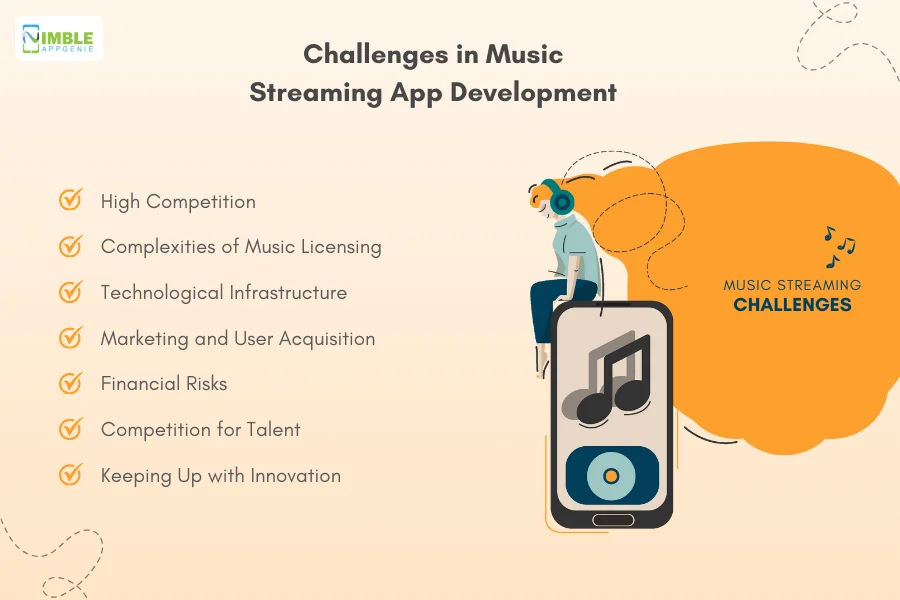
Here are 7 key hurdles to consider:
- High competition: The market is dominated by giants like Spotify and Apple Music, making it difficult to stand out and acquire users.
- Complexities of Music Licensing: Securing music licensing rights from artists, labels, and publishers is a complex and expensive process.
- Technological Infrastructure: Building and maintaining robust servers, data storage, and streaming protocols require significant technical expertise and resources.
- Marketing and User Acquisition: Effectively reaching and converting users in a crowded market requires strategic marketing campaigns and ongoing budget allocation.
- Financial Risks: Development, maintenance, and marketing costs can be high, with no guarantee of success or profitability.
- Competition for Talent: Hiring and retaining skilled developers, music industry professionals, and marketing experts can be challenging.
- Keeping Up with Innovation: The industry constantly evolves, requiring continuous adaptation and development of new features to stay competitive.
Conclusion
The journey to develop a music streaming app presents both exciting opportunities and daunting challenges.
While the market is thriving and ripe for innovation, it’s also fiercely competitive, requiring meticulous planning and execution.
From navigating complex music licensing agreements to staying ahead of technological advancements and continuously innovating features, the journey is demanding but rewarding.
By capitalizing on market trends, catering to evolving user preferences, curating exceptional content, and embracing innovation, aspiring businesses can carve a niche in this lucrative industry.
With careful planning, strategic monetization strategies, and a commitment to excellence, creating a music streaming app can lead to success in a dynamic and ever-evolving market.
It’s time to start your journey and disrupt the online music market, are you ready?
FAQs
Here’s how to create a music streaming app:
- Define your niche and target audience.
- Conduct market research.
- Choose a monetization strategy.
- Plan essential and advanced features.
- Secure music licensing agreements.
- Select a technology stack.
- Develop the app frontend and backend.
- Test rigorously.
- Launch and market your app.
- Frontend: React Native, Flutter, Native (iOS/Android)
- Backend: Node.js (Express), Python (Django/Flask), Java (Spring)
- Database: MySQL, PostgreSQL, Cassandra
- Streaming Protocol: HTTP Live Streaming (HLS), MPEG-DASH
- Cloud Infrastructure: AWS, Azure, Google Cloud Platform
- Authentication/Authorization: Firebase Authentication, AWS Cognito, Auth0
Development time varies depending on the feature set:
- Basic MVP: 3-6 months
- Complex: 12-18+ months
Cost range varies based on components:
- Basic Features: $5,000 – $15,000
- Complex: $50,000+
Monetization strategies include subscriptions, ads, in-app purchases, sponsorships, merchandise, etc.
Yes, the music streaming market is thriving, offering significant opportunities for new entrants to capture a share of the growing market. However, be prepared to face challenges such as high competition, complex music licensing, technological infrastructure, marketing, and user acquisition.

Yashshree Purohit, an experienced Technical Content Writer at Nimble AppGenie boasts over 5 years of expertise crafting compelling content across multiple domains. Passionate about transforming complex ideas into clear and compelling narratives, she excels in creating content that resonates with the audience.
Table of Contents




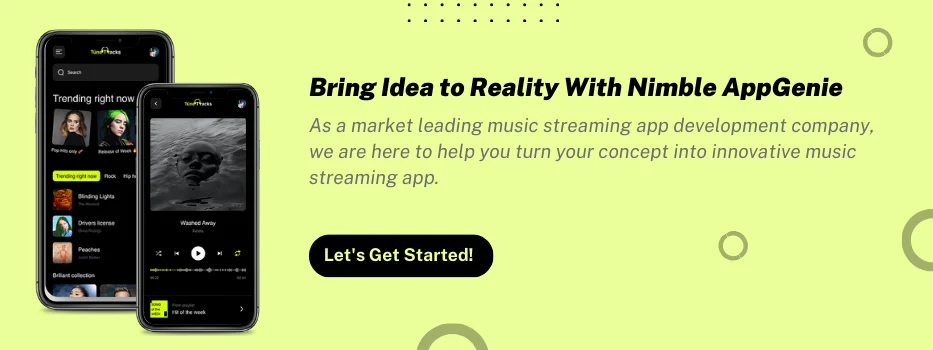
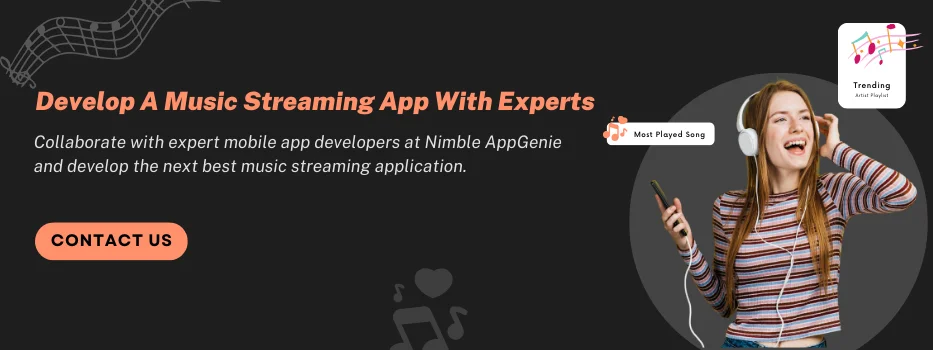








No Comments
Comments are closed.